Heading out the door? Read this article on the new Outside+ app available now on iOS devices for members! Download the app.
Nothing will make or break a night spent outdoors faster than the sleeping bag you crawl into when the sun goes down. A good sleeping bag is your last line of defense against the cold ground, biting winds, and plummeting overnight temperatures. And because a warm and comfortable sleep is crucial to waking up ready to tackle a long day of hiking, it’s important to find the right bag. Here are our top picks this year, from lofty down mummies to humidity-resistant synthetics.
Best Backpacking Sleeping Bags
- Best Overall: Argali Alpine 20 ($585)
- Best Sizing Options: REI Co-op Magma 30 ($379)
- Best Budget Bag: Kelty Cosmic Down 20 ($190)
- Most Versatile: Therm-a-Rest Boost 32 ($280)
- Best Affordable Synthetic: Exped DeepSleep 45 ($100)
- For the Quilt-Curious: Zenbivy Light Bed ($340-420)
- Most Sustainable: NEMO Disco 15 Endless Promise ($300)
- Best for Mountaineering: Mountain Hardwear Phantom 30 ($480)
- How to Choose a Sleeping Bag
- How We Test
- Meet Our Testers
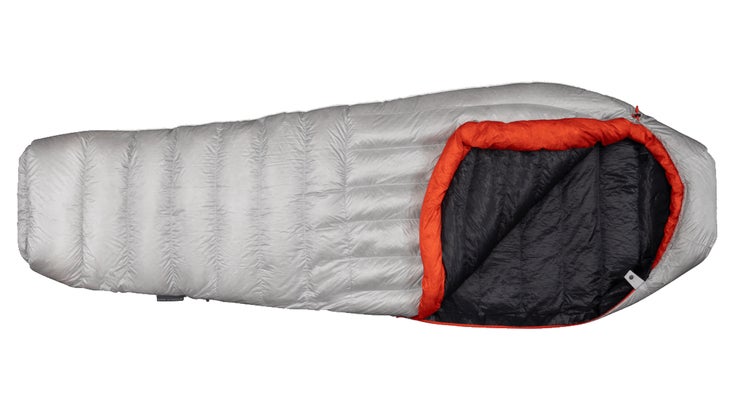
Best Overall
Argali Alpine 20
$585 at Scheel’s $585 at Argali
Weight: 1.9 lbs (regular)
Size: Regular and Long
Pros and Cons
⊕ Incredibly warm
⊕ Smart mix of features
⊗ Expensive
The best sleeping bags feel like a cozy cocoon you never want to leave. That’s exactly what we found with the Alpine 20, the first sleeping bag on offer from Argali, an upstart hunting brand that specializes in ultralight gear. The first thing our testers reported after a few nights in the Alpine was how warm it was. That’s in part because the Alpine uses top-flight materials, like 850-fill down and a 15-denier Pertex Quantum nylon shell. But there’s another reason: Argali bases its numbers on comfort ratings, where other bag manufacturers will advertise limit or survival ratings. What this means in the field is that the Alpine is one of the few 20-degree bags that kept even our cold-blooded testers warm and cozy at 20 degrees without extra layers. Warmth from 20 ounces of Allied Down is boosted by a draft collar that extends around the sizeable, cinchable hood and the entire length of the zipper. There are also buttonhole tabs inside the hood to attach Argali’s Elite Dream synthetic-fill pillow ($39.)
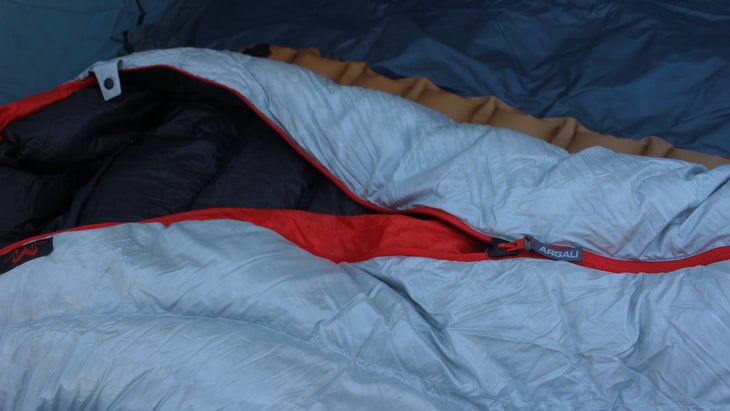
Comfort and practicality drove the rest of the design decisions for the Alpine . It sports a wider mummy shape that encloses without feeling claustrophobic. The main zipper is oversized and double-sided, so you can access it from within the bag. There’s also an extra stiff and durable strip of fabric running alongside the zipper that prevents the fragile nylon shell from getting caught in its teeth. Even the shock cord in the adjustable hood stood out to testers as being stouter and more durable than we’ve seen in similar lightweight bags. “It feels like they’ve prioritized ultralight down and fabrics, and then beefed up the surrounding hardware,” said one tester.
Those practical features mean that the Alpine, at 30 ounces, is a bit heavier than the most cutting-edge ultralight bags and quilts in its class and price range. But across the board, our testers said they’ll take the added warmth, leg room, and smooth zippers of the Alpine over just about any challenger. There was really only one thing we missed: an internal stash pocket, which testers like for protecting electronics and water filters from freezing overnight.
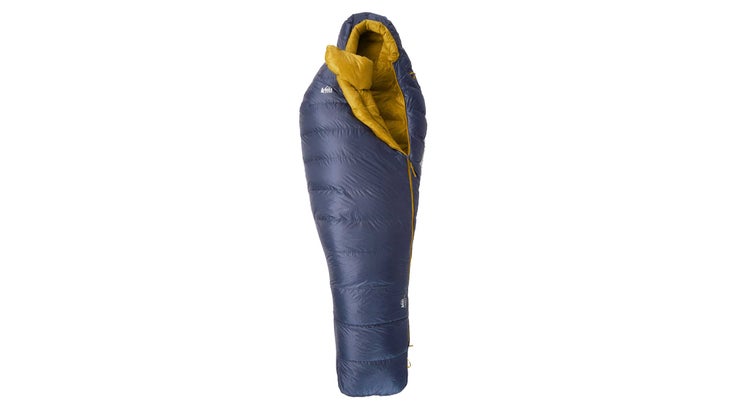
Best Sizing Options
REI Magma Co-op 30
Weight: 1.6 lbs (medium)
Size: Short, medium, and long, each with an option of narrow, regular, and wide versions
Pros and Cons
⊕ Generous size options
⊕ Feature-rich
⊗ Size range might require an in-person visit
When REI Co-op’s designers realized a few years ago that its existing backcountry sleeping bags, which came in a small range of men’s and women’s versions, fit only 50 percent of its demographic, the company ditched its gender-specific bags. Last year, the company released nine new unisex sizes in its popular Magma line.
The 30-degree, 850-fill goose-down mummy, which packs down to the size of an airplane pillow, was Minnesota-based tester Brian Hayden’s favorite bag in the test. At 5’10” and 175 pounds, he found that the roomy, medium-sized Magma’s updated mummy shape with a trapezoidal footbox and snug hood was just right for his body. During an early autumn week when overnight temps dropped to 42 degrees, he snoozed away, cowboy camping under the stars without so much as a shiver. Fifteen-denier, DWR-coated recycled nylon on both the interior and exterior kept the morning dew from soaking in and wicked moisture away. What made this Hayden’s dream bag were the extra details: a roomy footbox; a beefy, easy-to-use two-way zipper that allowed him to vent near his feet; and a down draft collar at the front of the bag to keep the neck cozy and the zipper off the face.
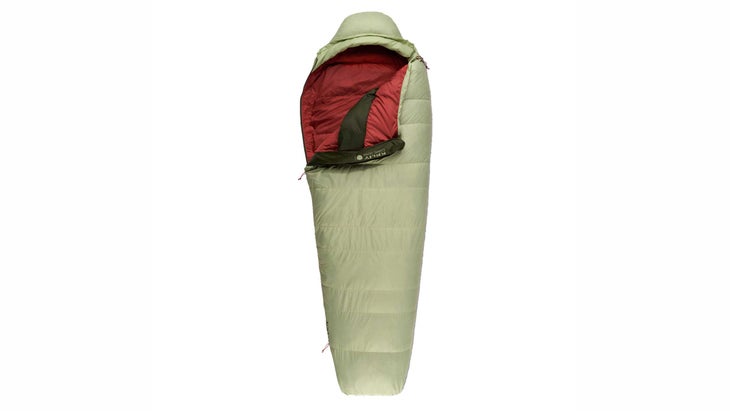
Best Budget
Kelty Cosmic Down 20
$200 at Backcountry (Women’s) $170 at Backcountry (Men’s)
Weight: 3.3 lbs (women’s), 2.4 lbs (men’s regular)
Size: Regular, Long
Pros and Cons
⊕ Affordable
⊕ Silky-soft
⊗ Heavy
Despite its trendy appeal, ultralight gear isn’t a necessity for most backpackers. If you’re comfortable carrying a few extra ounces and all you need is a cozy bag that can easily handle three seasons, the updated Kelty Cosmic Down 20 ticks all the boxes. It’s now slightly roomier, with an expanded footbox, and also more sustainable, with a durable 20-denier nylon taffeta shell, PFAS-free DWR, and silky-soft 50-denier polyester taffeta interior—both 100-percent recycled.
Testers who sampled the women’s version came away more impressed than those who used the men’s. That’s primarily down to warmth: the women’s model has a whopping 13 ounces more 550-fill power duck down packed inside, which is about the biggest difference we’ve ever seen in fill weight based on gender. The result? The women’s model felt true to the temperature rating, while the men’s version felt more like a summerweight bag.
We tested the women’s model while canoe-camping in Minnesota’s Boundary Waters Canoe Area Wilderness, where temps dipped into the low 40s overnight. By unzipping the two-way zipper from the bottom and letting fresh air circulate in the footbox, our tester didn’t feel overly hot. On a second northern Minnesota overnight later in the fall, when temperatures hit the mid-30s, that same tester appreciated the draft tube, collar, and tight-cinching hood. All bundled up, the 20-degree comfort rating felt right on—we wouldn’t want to take it into much colder conditions. The next morning, the DWR-treated shell easily shrugged off condensation (the down itself is not treated).
New wiggle room in the already-generous hip (56 inches) and shoulder regions (58 inches) was great for folks with hourglass-shaped bodies, but our 5’9” tester found the bag to be a bit too short—and there’s only one size in the women’s version. It’s also more than twice the weight of other three-season bags, only scrunching down to the size of an XXL paper towel roll (the synthetic-filled draft and zipper collars don’t help). But for an easy paddling trip where space and weight were not an issue, this bag was a cozy, budget-friendly no-brainer.
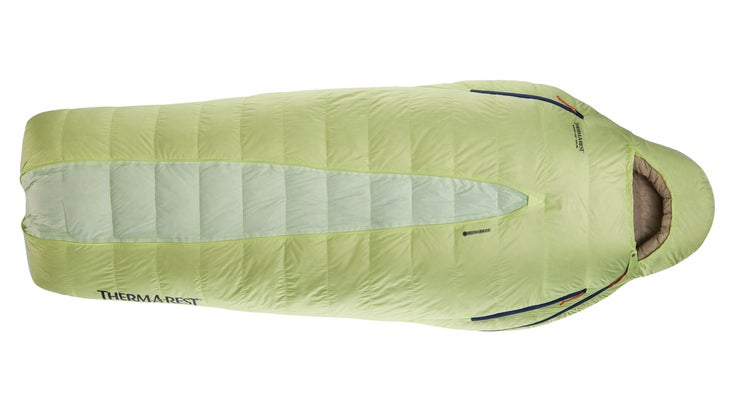
Most Versatile
Therm-a-Rest Boost 32
$280 at REI $280 at Backcountry
Weight: 2.1 lbs (regular)
Size: Short, Short Wide, Regular, Regular Wide, Long, and Long Wide
Pros and Cons
⊕ Spacious
⊕ Arm holes
⊗ 650 fill down is weighty
One of the biggest deciding factors when choosing a bag is its shape. A narrow mummy design can be snug and warm on a cold night, but too restrictive otherwise. A semi-rectangular shape, on the other hand, lets you move around but is less efficient when temps drop. Therm-a-Rest’s answer to this age-old dilemma is the Boost, a new bag built around a center zip that changes both the shape and temperature rating of the bag. Unzipped, the Boost has a semi-rectangular shape. Zip it up, and the 650-fill down insulation along the center of the bag folds in on itself, creating a slimmer profile and doubling the insulation over your core. Add in zippered arm holes that let our testers stay engulfed in down while organizing gear in the tent or cooking a meal, and the result is the most versatile bag we’ve tested in recent years.
The trade-off for all that versatility is added weight. Between the less-lofty-than-average 650-fill down and the four zippers, the Boost is far from the lightest three-season bag we tested. Like many bags we test, the Boost wasn’t quite true to its rating, either. One tester said it served admirably down to 40 degrees with the center zip closed, which seemed to boost the temperature rating by about 5 degrees compared to leaving it open. But they were impressed by the durability of the 20-denier recycled nylon shell with a PFAS-free water repellant. “We go backpacking with our dog, and she stomps around and kicks us in the tent all night,” another tester reported. “The bag was no worse for wear after several trips.”
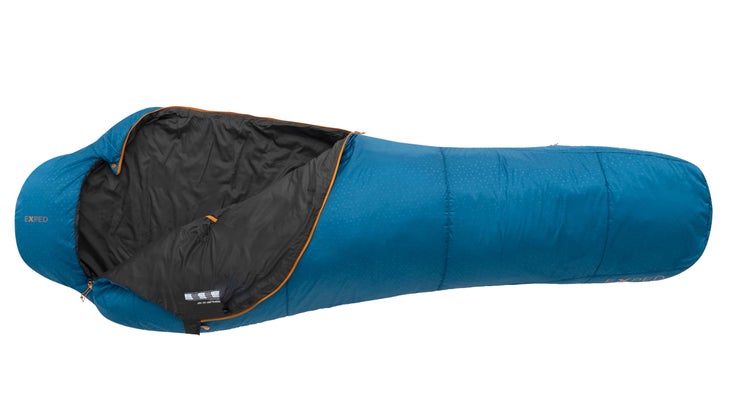
Best Affordable Synthetic
Exped DeepSleep 45
$100 at Exped $100 at Black Ovis
Weight: 2 lbs (medium)
Size: Medium, Large
Pros and Cons
⊕ Very affordable
⊕ Sustainable/recyclable monomaterial design
⊗ Heavy for the warmth
If you’re an occasional—and fair weather—backpacker, we’ll let you in on a secret: There’s no need to buy an expensive down bag that’s designed to brave colder weather. Our favorite super-affordable bag is Exped’s newest synthetic model, the Deep Sleep 45. It has a no-nonsense design, with a three-quarter-length zipper and a full, adjustable hood. The 40-denier polyester shell, while not the softest, proved resilient during one tester’s three-week road trip through the Eastern Sierra in California. “It did everything I asked of it, and when I got home I could throw it in the laundry with my dirty clothes,” she said. “It’s so easy compared to my down bag.” (Down bags require a special down wash and much longer drying times).
Compared to top-flight summer bags, the DeepSleep simply can’t compete on weight. But it packs down to the size of a watermelon, and at just over 2 pounds, is still well within the size and weight limits of a backpacking bag. That’s helped along by its narrow mummy cut, which might feel restrictive if you’re accustomed to semi-rectangular bags.
One word of warning: After years of testing, our team is cautious of temperature ratings, especially for lightweight synthetic bags. The DeepSleep is no exception, in that our testers did not all find it warm at 45 degrees. It’s a true summer-only bag, and works best when you don’t expect temps to drop below 55. If that sounds like your kind of backpacking trip, it’s hard to go wrong, especially for the price.
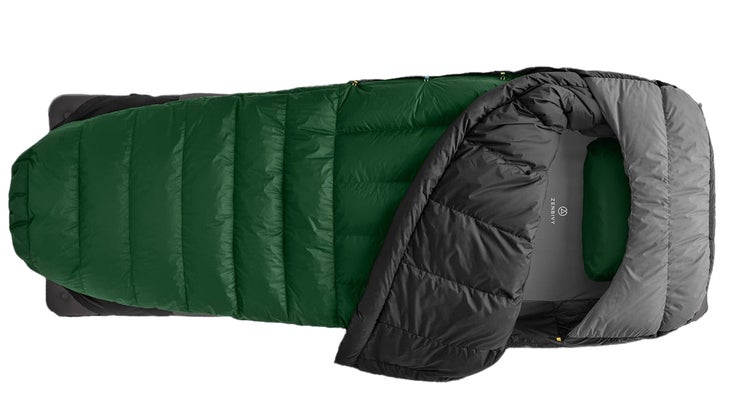
For the Quilt-Curious
Zenbivy Light Bed 25
$210 at Zenbivy (Quilt) $45 at Zenbivy (Sheet)
Weight: 1.4 lbs (quilt); 3.5 oz (uninsulated sheet), 7 oz (insulated sheet)
Size: Regular, Large, Extra Large
Pros and Cons
⊕ Combines perks of bags and quilts
⊕ Less drafty than most quilts
⊗ Finicky setup
Look at a thru-hiker’s gear list, and you’re just as likely to see a quilt as a sleeping bag. They’re light, versatile, and more popular than ever. They’re also not for everyone. If you can’t make up your mind between a potentially drafty quilt and a restrictive bag, the Zenbivy system is a good go-between. The Light Bed 25 combines a standard hoodless quilt and a hooded “sheet” that slips over a sleeping pad. The two are purchased separately, allowing you to mix and match depending on the features you’re after, but designed to fit together seamlessly. The result? A setup that has perks of both bags and quilts. “I can’t stand a mummy bag because of how constricting they feel,” one tester said. “Setting this up for the first time took a few minutes, but it turned out to be the right mix of comfort and security for me.”
That comfort is boosted by an updated 25-denier pongee-style polyester liner, with an extra-tight weave and a soft, cool feel against the skin. We also liked the range of options available. The quilt is available with a sewn or an adjustable footbox. The sheet comes in two widths (25” and 30”; for a 20” option, go with the lighter, slightly more expensive ultralight sheet) and two lengths (the full-length sheet covers the entire sleeping pad but adds weight). The hood can be uninsulated or down-filled for extra warmth. Finally, the entire system is also available in a 10-degree temperature rating.
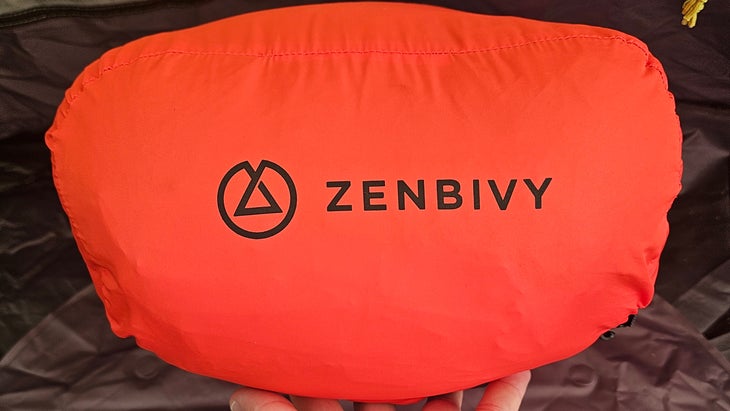
After a summer of testing, our team reported that the Zenbivy system really does cut back on cold drafts along the sides of the quilt, which has always been one of our chief complaints for standard quilts—especially when side-sleeping. That’s thanks mostly to one small design tweak: The color-clips on the quilt are set in from the edges, ensuring that the quilt and sheet will always overlap, even if you’re shifting around. This keeps you on the pad and keeps the edges of the quilt wrapped around your body. Ultimately, the Zenbivy system isn’t the lightest available (with the sheet, the Light Bed is about the same weight as a quality 25-degree bag), but its versatility is top-notch. If you like the extra movement and space a quilt provides, but can’t deal with drafts, Zenbivy is worth a look.
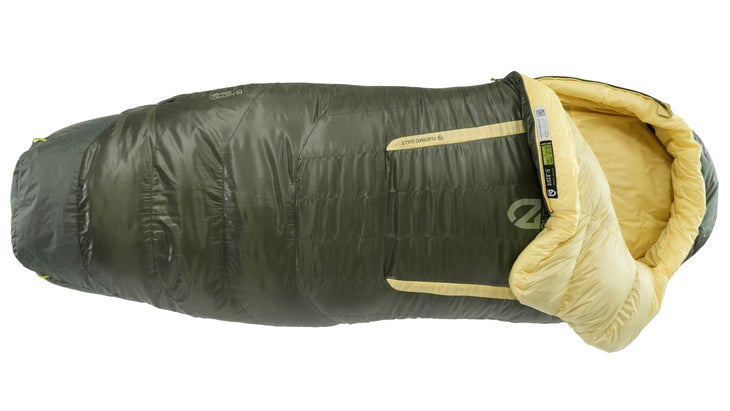
Most Sustainable
NEMO Disco 15 Endless Promise
$300 at REI (Women’s) $300 at REI (Men’s)
Weight: 2.7 lbs (men’s regular)
Size: Men’s regular and long, women’s regular and long
Pros and Cons
⊕ Well-priced
⊕ Relatively sustainable
⊕ Comfortable
⊗ No interior pocket for small items
The updated NEMO Disco was the crowd-pleaser of our test batch this year for myriad reasons: The mummy has a roomy spoon shape, which is more spacious at the elbows and knees, making it exceptionally comfortable, especially to side and stomach sleepers. Two multi-position ventilation zippers on top of the bag—in addition to the full-length side zipper—and an oversized draft collar offered multiple ways to regulate temps. And the interior polyester fabric felt soft, silky, and cool to the touch. This is old news for Disco lovers. What’s laudable is that our testers still feel this way when almost the entire bag is now fully recyclable.
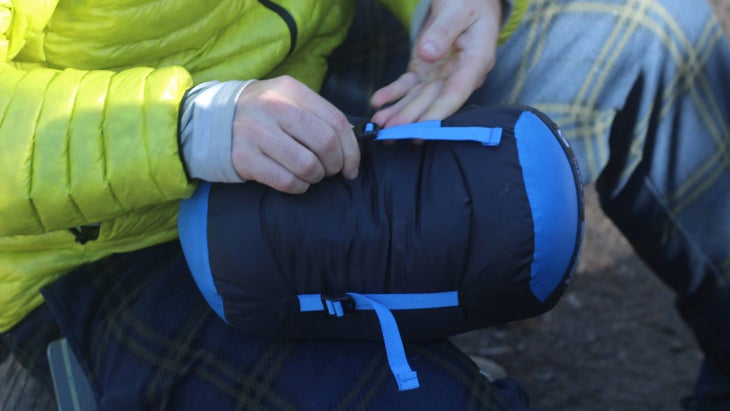
Everything—from the face fabric to the down—is recycled when you send it back to NEMO at the end of its life. To prolong that life, you can also send the bag to the brand’s in-house repair shop for patching. If you relinquish your bag in serviceable condition, it’ll be resold. On top of that, the lining, PFAS-free DWR-treated polyester shell, and waterproof, PET-coated hood and footbox are all made of recycled materials themselves. For a piece of plastic as large as a sleeping bag, we think NEMO’s program is especially important—and leagues ahead of most other brands.
Tester Jen Pearson used the bag on two separate trips into Minnesota’s Boundary Waters Canoe Area Wilderness and Canada’s Quetico. When she slept in it during a torrential downpour with a wet, tired, white lab snuggled next to her, the bag stayed mostly dry with the exception of some clamminess inside the toebox, which dried quickly in the sun the next morning. The neck flap was comfortable, not claustrophobic, adding extra warmth and coziness in the coldest hours of her midsummer testing, when temps got close to the bag’s 27-degree comfort rating. “It kept both me and my dog quite cozy through a cold, wet night and cool on an unseasonably warm night,” says Pearson. “I slept great!”
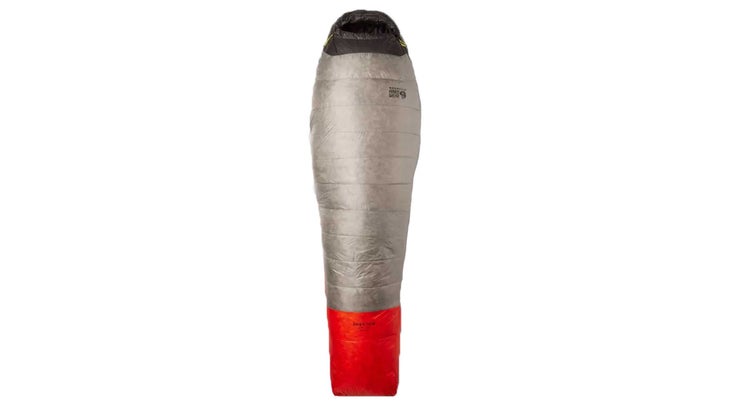
Best for Mountaineering
Mountain Hardwear Phantom 30
$480 at REI $480 at Backcountry
Weight: 1.4 lbs (regular)
Size: Short, Regular, Long
Pros and Cons
⊕ Extremely compact
⊕ Dries out quickly
⊗ Snug fit
Mountain Hardwear’s Phantom 30 has long been a go-to bag for mountaineers and backpackers due to its packability-to-warmth ratio. And while the designers didn’t want to mess with a proven classic, recent improvements in fabric and design made it even more desirable, according to tester Hansi Johnson, who used the updated Phantom 30 while on a fall fishing trip to Minnesota’s Voyageurs National Park. His reasoning was simple: At a pound and a half, it still provided the warmth he needed on a sub-freezing, crystal-clear night sleeping sans tent on the top deck of a houseboat.
Overall, the bag is more durable and weighs less than the old Phantom, packing down to the size of about two Nalgenes. The 800-fill goose-down insulation and 10-denier recycled nylon shell fabric are the same, but Mountain Hardwear replaced the taffeta lining with a 15-denier ripstop nylon lining that’s more durable, comfortable, and wraps around the hood for added protection. Because the lining is black and absorbs sunlight, the bag dries out faster, too. Mountain Hardwear also replaced the fabric along the zipper with a tough, lightweight 40-denier fabric.
During Johnson’s trip to Voyageurs, temps dropped well below freezing, which left him with a shimmering coat of frost in the morning. Despite the early season freeze, says Johnson, “the bag kept me warm and dried quickly in the sun. It’s still a no frills, go get ’em bag.”
How to Choose a Sleeping Bag
Finding the ideal sleeping bag or quilt is a little like finding the ideal life partner. When you start looking, the options might seem overwhelming. But the more you focus on what you really want, the easier it is to narrow down. Below are four questions to ask yourself as you search for your perfect sleeping mate.
In What Season(s) Will I Use the Bag?
Bags generally fall into three temperature categories: summer (rated 30 degrees F and warmer); three-season (rated between 15 and 20 degrees); and winter (rated 15 degrees and lower—some expedition bags are rated as low as -40 degrees). These temperature ratings are based on “average” sleepers and don’t consider external factors like the thickness and rating of your sleeping pad; climatic factors like wind or humidity; or how quickly your body regulates heat loss or gain. Unless you know that you consistently sleep hot, we recommend buying a bag that’s rated 10 degrees warmer than your expected low. You can always open zippers, but making a bag warmer requires extra layers.
What Activity Will I Be Doing?
Recreationalists who need ultralight gear, like bikepackers, thru-hikers, or ultra-runners, will want a bag that offers maximum warmth for minimal weight—something they can stuff down to the size of a Nalgene and jam into a pack. Quilts are a popular choice for those trying to cut weight. For shorter backpacking trips or where weight isn’t a priority, you can find considerable savings and comfort in a bag that is slightly heavier or bulkier due to lower fill power or cheaper materials.
What Type of Insulation Is Best for Me?
Down bags are generally warmer for their weight and more compressible than bags with synthetic insulation. But down bags get wet, take longer to dry out than synthetic bags, and lose insulating capacity. Many manufacturers use down processed with a hydrophobic chemical that prevents it from absorbing as much water. Others keep the insulation dry with a water-repellant finish or fabric. Pay attention to fill power. That number measures the volume taken up by the amount of down in your sleeping bag; the more loft your sleeping bag has, the more efficiently it will trap warm air. It will also weigh less and pack down smaller than bags with a lower fill power rated to the same temperature. Synthetic bags are more affordable, and therefore an excellent choice for new campers who are unsure how often they want to sleep outside, or backpackers who are headed to wet environments.
How Much Space Do I Need?
Bags come in many shapes and sizes—rectangles, mummies, modified mummies, and double bags. Mummies are warmer and lighter-weight than rectangular bags, but can also be claustrophobic. Rectangular bags are excellent for restless sleepers who need to move and don’t have space or weight constraints. Some quilts can be opened up to act as comforters, although they require a warm sleeping pad and don’t come with hoods. Women-specific bags often come in modified mummy shapes to accommodate the curvier parts of a woman’s body. Doubles are simply a sleeping bag built for two, although many solo bags can be zipped together to create a double bag.
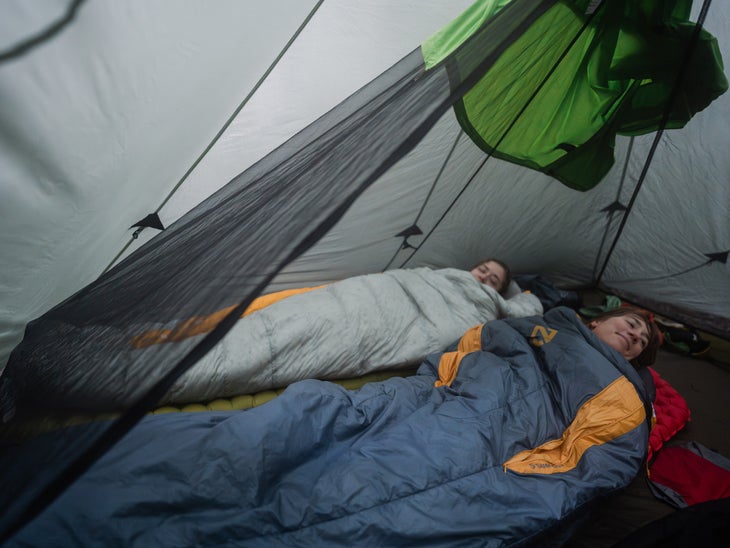
How We Test Backpacking Sleeping Bags
- Number of Testers: 13
- Number of Bags and Quilts Tested: 28
- Number of Nights Slept Outside: 112
- Coldest Night: 14 degrees
- Warmest Night: 78 degrees
Every year, we gather the latest sleeping bags and quilts from every brand we can find, including industry powerhouses and small-time startups. Over the course of a year, we compare them to the best options we’ve tested in the past, putting together a comprehensive guide that includes the latest releases and tried-and-true favorites.
Once testing begins, it’s all about one thing: sleeping outside as often as possible. This year’s testers ranged from experienced thru-hikers to brand-new backpackers, and we took trips across the Pacific Northwest, along the length of the Pacific Crest Trail down to Baja, Mexico, among many other locations.
During testing, our team took detailed notes covering just about everything: fabrics, zippers, loft, features, construction, sizing, and more. After a long season of testing, our category manager narrowed down the top contenders and put them head-to-head, vetting comfort, ease of use, warmth, durability, and price.
Meet our Testers
Nathan Pipenberg is our category manager for backpacking sleeping bags, pads, and trekking poles. He’s also Backpacker’s ultralight columnist, a thru-hiker, a one-time trail builder and wildland firefighter, and enjoys making his own backpacking gear in his free time.
Hansi Johnson is a lifelong backcountry camping and travel enthusiast. He spends a lot of time wandering the Boundary Waters Canoe Area and beyond regardless of the season. Johnson works for the Minnesota Land Trust advocating for Minnesota’s natural spaces. He lives in Thomson, Minnesota, with his wife Margaret and his son Tae.
Will McGough is a veteran outdoor writer and gear tester who has worked with Backpacker since 2015. He also serves as the Gear Guide’s category manager for backpacking tents.

